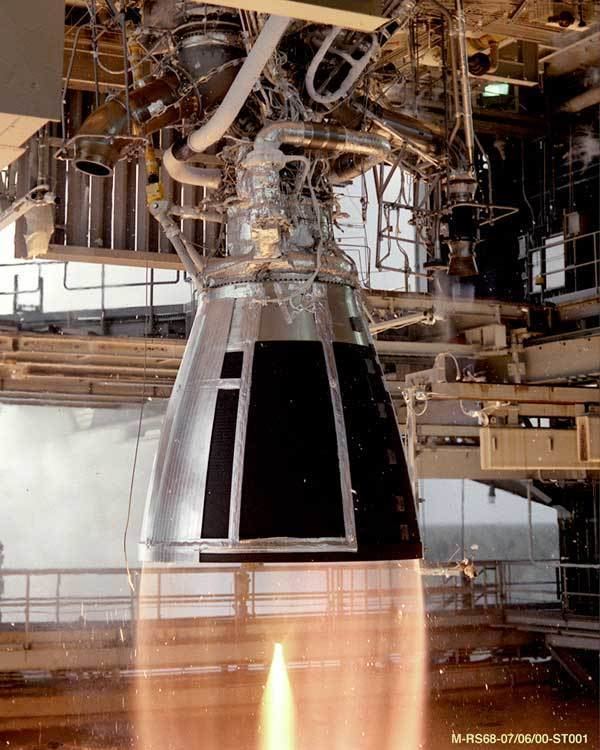Country of origin United States Cycle Gas-generator cycle | Propellant LOX / LH2 Nozzle ratio 21.5 | |
 | ||
Application First stage engine for Delta IV rocket | ||
The Aerojet Rocketdyne (formerly Rocketdyne and later Pratt & Whitney Rocketdyne) RS-68 (Rocket System 68) is a liquid-fuel rocket engine that uses liquid hydrogen (LH2) and liquid oxygen (LOX) as propellants in a gas-generator power cycle. It is the largest hydrogen-fueled rocket engine.
Contents
Its development started in the 1990s with the goal of producing a simpler, less-costly, heavy-lift engine for the Delta IV launch system. Two versions of the engine have been produced: the original RS-68 and the improved RS-68A. A third version, the RS-68B, was planned for NASA's Ares V rocket that was later canceled.
Design and development
A leading goal of the RS-68 program was to produce a simple engine that would be cost-effective when used for a single launch. To achieve this, the RS-68 has 80% fewer parts than the multi-launch Space Shuttle Main Engine (SSME). Simplicity came at the cost of lower thrust-efficiency versus the SSME: the RS-68's thrust-to-weight ratio is significantly lower and its specific impulse is 10% lower. The benefit of the RS-68 is its reduced construction cost. The RS-68 is larger, and more powerful than the SSME and it was designed to be a more cost-effective engine for an expendable launch vehicle.
The engine uses a gas generator cycle with two independent turbopumps. The combustion chamber uses a channel-wall design to reduce cost. This design, pioneered in the former Soviet Union, features inner and outer skins brazed to middle separators, forming cooling channels. Although this method is heavier, it is much simpler and less costly than the tube-wall design (using hundreds of tubes, bent into the shape of the combustion chamber and brazed together) used in other engines. The lower nozzle has an expansion ratio of 21.5 and is lined with an ablative material. The nozzle's lining burns away as the engine runs, dissipating heat. This ablative coating is heavier than other engines' tube-wall nozzles but much easier and less expensive to manufacture. The presence of carbon in the exhaust from the ablative carbon-containing inner nozzle lining can be inferred by the yellow color of the engine exhaust, unlike the SSME's nearly-transparent flame of pure hydrogen burning. The combustion chamber burns liquid hydrogen and liquid oxygen at 1,486 lbf/in2 (10.25 MPa) at 102% power with a 1:6 engine mixture ratio.
The RS-68 was developed at Rocketdyne Propulsion and Power, located in Canoga Park, Los Angeles, California, where the SSME is manufactured. It was designed to power the Delta IV Evolved Expendable Launch Vehicle (EELV). The initial development engines were assembled at the nearby Santa Susana Field Laboratory where the Saturn V F-1 engines were developed and tested for the Apollo missions to the Moon. The RS-68 had initial testing done at Air Force Research Lab, Edwards AFB and later at NASA's Stennis Space Center. The first successful test firing at AFRL was completed on September 11, 1998. The RS-68 was certified for use on Delta IV in December 2001. The first successful launch using the new engine and launch vehicle occurred on November 20, 2002.
The RS-68 is part of the Common Booster Core (CBC) used to create the five variants of the Delta IV family of launch vehicles. The largest of the launch vehicles includes three CBCs mounted together for the Heavy.
At a maximum 102% thrust, the engine produces 758,000 pounds-force (3,370 kN) in a vacuum and 663,000 pounds-force (2,950 kN) at sea level. The engine's mass is 14,560 pounds (6,600 kg) at 96 inches (2.4 m). With this thrust, the engine has a thrust-to-weight ratio of 51.2, and a specific impulse of 410 s (4.0 km/s) in a vacuum and 365 s (3.58 km/s) at sea level. The RS-68 is gimbaled hydraulically and is capable of throttling between 58% and 101% thrust.
The RS-68A is an updated version of the RS-68, with changes to provide increased specific impulse and thrust (to over 700,000 pounds-force (3,100 kN) at sea level). The first launch used three RS-68A engines mounted in a Delta IV Heavy. This first launch occurred June 29, 2012 from the Cape Canaveral Air Force Station.
Proposed uses
In 2006, NASA announced that five RS-68 engines would be used instead of SSMEs on the planned Ares V (CaLV). NASA chose the RS-68 because of its lower cost, about $20 million per engine after NASA upgrades. The modifications to the RS-68 for the Ares V included a different ablative nozzle to accommodate a longer burn, a shorter start sequence, hardware changes to limit free hydrogen at ignition, and changes to reduce helium use during countdown and flight. Thrust and specific impulse increases would occur under a separate upgrade program for Delta IV. Later the Ares V was changed to use six RS-68 engines, designated RS-68B. Ares V was canceled along with Project Constellation; NASA's successor heavy-lift vehicle, the Space Launch System, will use a variant of the RS-25, the Space Shuttle Main Engine (SSME).
The DIRECT alternative launch project included two or three RS-68 engines in "version 2.0" of the team's proposal, but switched to the SSME for "version 3.0".
Human-rating
It would reportedly require over 200 changes to the RS-68 to meet human-rating standards. NASA states several changes are needed to human-rate the RS-68, including health monitoring, removal of fuel-rich environment at liftoff, and improved subsystems robustness.
